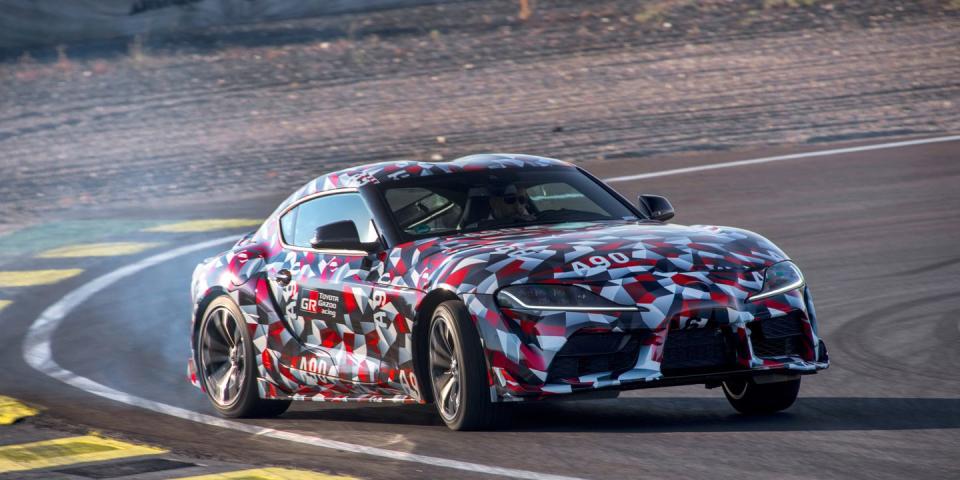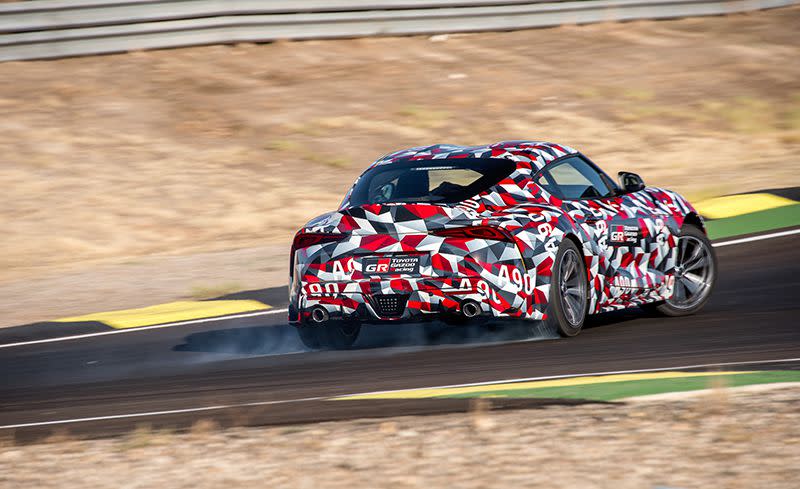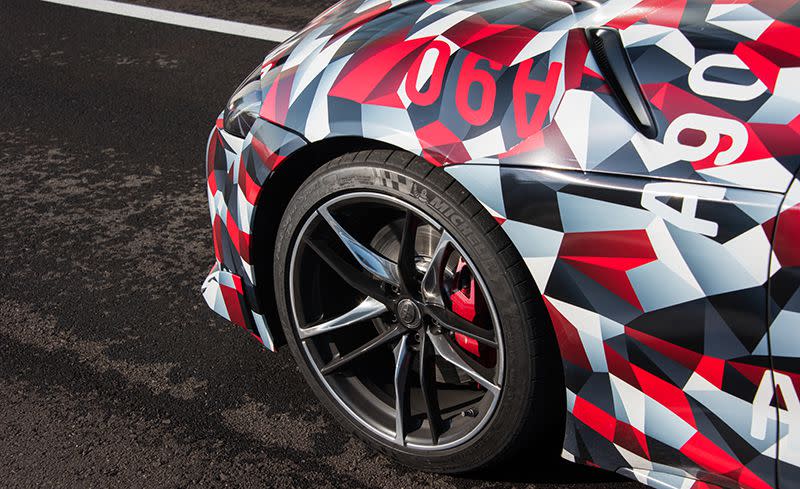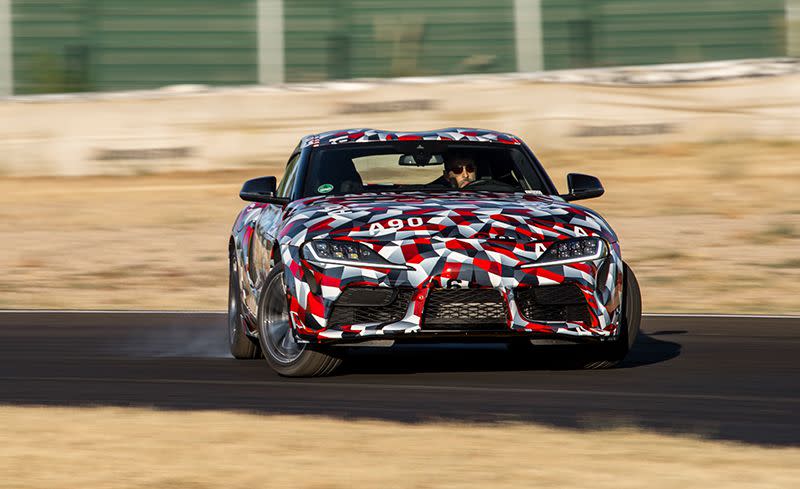The 2020 Supra Proves Toyota Hasn't Forgotten How to Make a Sports Car

If someone 10 years from now pops the hood of a lightly wrecked 2020 Toyota Supra and says, "B58 engine, no shiz," or whatever profanity is popular at the time, we'd be surprised. Not that there is anything wrong with the BMW inline-six. In fact, it is one of the smoothest and lag-free turbocharged engines in the world. If you were setting out to build a rear-wheel-drive sports car powered by a turbocharged inline-six, it's about as good a starting point as you could find. Some will still consider it sacrilegious to power a Supra with anything but the legendary 2JZ inline-six of the Mark 4 Supra and, less importantly, The Fast and The Furious fame.
Those two things-chassis layout and engine configuration-are the only elements of heritage that carry over from the fabled fourth-generation A80 Supra to this new A90 Supra. The gap between them stretches over enough years to grow an adult driver from scratch, after all. Conceivably, other nuggets of commonality might be found in the specifications, but for now, Toyota is keeping a tight lid on those details. Before cutting us loose on a racetrack and roads used as rally stages north of Madrid, Spain, assistant chief engineer Masayuki Kai gave us one quasi-spec: The new Supra's wheelbase-to-track ratio would be at least 1.6:1 for optimal handling, but he wouldn't reveal either dimension. Nearly every other question about metrics was answered with an inequality. "More than" 300 horsepower. A zero-to-60-mph time of "less than" five seconds. A target curb weight of "about" 3300 pounds. You get the picture.
Kai-san makes it pretty clear that Toyota wants us to think less about the numbers and more about how its new hero car feels. But to review, this is what we know: Toyota has revived the Supra name for a new sports car in a collaboration with BMW. BMW gets the roadster Z4, which we've had a similar exposure to, while Toyota gets the coupe. As we mentioned, BMW supplies the engine, and it's paired with ZF's ubiquitous eight-speed automatic. Both cars will be manufactured by Magna Steyr in Austria. The Supra will hit dealerships midway through 2019 as a 2020 model and probably will ring in at about $50,000. Most, if not all of the camouflaged switchgear we saw in the cabin also looked BMW-like. If earlier reports are to be believed, the engine will flaunt 335 horsepower, and an inline-four also is in the works but won't be offered at the start.
Feels Right
We were fully expecting the Supra to be much like a modern BMW, which is to say plenty capable but a little numb. Instead, there is a smoothness to the Supra that we haven't felt in a BMW in years. Turn-in is crisp without being too heavy. The claimed 50/50 front/rear weight distribution-there's a spec-lends itself to tuning for minimal understeer, while an electronically controlled limited-slip differential ensures great traction on corner exit. The transmission's logic in Sport mode makes shifting with the paddles an exercise in vanity.
The one dynamic component that could still use some attention from the engineers is in the brake tuning. The pedal never had that "I'm a track car, stand on me with confidence" feel, instead evincing a dead spot in the initial travel and a generally spongy response. Both the Jarama circuit and the nearby rally roads are taxing venues for brakes, and while what we felt could have been the residual effects from repeated abuse, we can't say for sure because we never got in a fresh car. That said, the brakes never gave up, and there wasn't so much as a single pucker moment.
With a nearly identical component set as the BMW-including adaptive dampers, a shear plate stiffening the front end, 19-inch BMW-spec Michelin Pilot Super Sport tires (17- and 18-inchers will be available, too), and Brembo brake hardware-the Supra's tuning limitations were defined by a crisp box. The personality instilled in the chassis comes down to the critically important knobs that Toyota controlled. When asked what the Toyota engineers thought of the Z4, they had no answer-not because they didn't want to badmouth the competition/partner, but because they had never driven nor even laid eyes on a Z4.
Both based in Munich, the Z4 and Supra engineering teams split four years ago and haven't communicated about the development paths they've followed since. Kai-san remembers fighting for a little more control over the engine. It wasn't loud enough (the European models are downright quiet), and he wanted to get more sound to tickle the heartstrings. Concessions were made, and Toyota got its way. Sport mode opens a butterfly valve in the exhaust and there is, unfortunately, some faux noise pumped through the stereo. European pass-by-noise standards are tough, but we're told the U.S. market will get a louder exhaust than the one on the cars we drove.
Designed for Toyota Fans
If the attention these camouflaged prototypes received in Madrid is any indication, the car won't need the exhaust to turn heads. The shape is nearly identical to that of the aggressive FT-1 concept shown in Detroit back in 2014. What doesn't show through the camo is that, despite the Bavarian roots, this is an unmistakably Japanese design. Cues from two of the great '90s Japanese cars are present. The rounded nose and front overhang are unmistakably A80 Supra influences. Resemblance to the FD Mazda RX-7 is seen in the double-bubble roof as well as in the taillights split by a ducktail spoiler integrated with the hatch; it's different from the Mazda in detail but similar in concept. Either way, this new, A90 Supra has a distinctive exterior you won't mistake for anything European.
Driver comfort is exceptional for such a tightly packaged cabin. The roof carves out more headroom than the exterior suggests, although mid-six-footers will find it tight. The C7 Corvette is the poster child for practicality in two-seaters, and the Supra won't dethrone it. An hourglass-shaped hatch opening looks to have the room to squeeze a set of golf clubs into the cargo bay, but not much more will fit.
Only Finishing Touches Remain
According to engineers, the cars we drove were 90 percent complete. Just a few more tuning tweaks plus some decisions on interior elements and option packages remain to be decided before it gets the final stamp of approval. By the time that comes, the Munich-based team will probably be working on variants such as the aforementioned four-banger; a targa roof is still possible, and there may yet be a manual transmission, although the latter is unlikely with the six because of concerns over shift quality with such a torque-rich engine.
It has been a very long time since there was a Toyota sports car filling the gaping void in the showrooms between the budget-conscious 86 and budget-be-damned, now-discontinued Lexus LFA. The Supra is poised to fill it. Kai-san said, "We believe this will be the final generation of Supra with just internal combustion." We're never going to live long enough to hear, "AC motor, no shiz." It's a great thing to know that a 90-percent-finished Supra is so good to drive, and we're looking forward to actually seeing it. Reactions will likely include profanity.
('You Might Also Like',)

 Yahoo Autos
Yahoo Autos 


